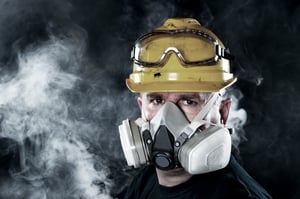 From making sure safety rules are followed to providing all the necessary equipment, protecting the health and safety of workers on the job should be a top priority of any employer. For those whose work environment may produce potentially harmful particles or vapors, protection will come partly in the form of a properly fitted and functional respirator.
From making sure safety rules are followed to providing all the necessary equipment, protecting the health and safety of workers on the job should be a top priority of any employer. For those whose work environment may produce potentially harmful particles or vapors, protection will come partly in the form of a properly fitted and functional respirator.
What is a Respirator Fit Test?
If OSHA requires your employees to wear respirators, they will also need to undergo a respirator fit test to ensure the equipment satisfies safety standards. This test should be conducted using the NIOSH-certified respirator that the employee will be wearing. Employees should also bring any other protective equipment which may affect the fit such as safety goggles, and male employees must be clean shaven. Before testing can begin, a medical evaluation must be conducted by a physician or other licensed health care provider (PLHCP).
Qualitative vs Quantitative Respirator Fit Testing
There are two primary types of respirator fit testing: qualitative and quantitative. Each serves its own unique purpose:
- Qualitative Fit Test (QLFT) - This test can be used for testing of negative pressure respirators and tight-fitting face pieces that are used in conjunction with atmosphere-supplying and powdered respirators. These tests rely on the users on senses and one of four OSHA-approved test agents:
- Isoamyl Acetate: has a distinct, banana smell
- Saccharin: has a sweet taste
- Bitrex: has a bitter taste
- Irritant Smoke: causes coughing
The user will be instructed to do things such as take deep breaths, move the head around and bend over. If no odor, taste or irritation occurs, the respirator has passed.
- Quantitative Fit Test (QNFT) - This test checks for a proper seal around a tight-fitting respirator and produces a number called a "fit factor." There are three OSHA-approved methods for performing respirator QNFTs:
- Generated Aerosol: The respirator is used in a test chamber where aerosol is dispensed and leaks are measured.
- Ambient Aerosol: Leaks are measured using special technology that does not require the use of a test chamber.
- Controlled Negative Pressure: A vaccuum is created around the face piece to measure leaks.
In order to pass, a half-mask respirator must score a fit factor of at least 100, while a full-mask respirator must score at least 500.
Respirator Fit Test in Zachary
In Zachary, Lane Regional Medical Center offers a full range of occupational health and wellness services to area employers through our WellnessWorks program, including respirator fit testing and associated medical exams. Currently, during the COVID-19 pandemic, FASTLane is reserving the hours of 7-9 AM, Monday - Friday for occupational medicine services such as fit testing only! To learn more about these services for your own employees, click the button below.




